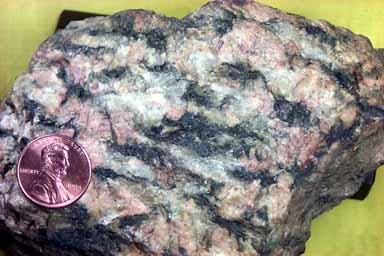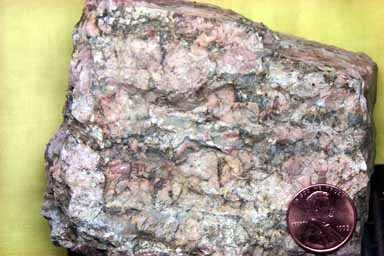The Weathering of a Granite
The three pictures below are of the same coarse grained granite with pink orthoclase feldspar in various stages of weathering. They all came from the same outcrop. The sample on the right is one that is almost pristine, with little weathering. Notice the pink orthoclase, black amphibole, and clear glassy quartz. All these are hard, durable minerals, bright and shiny. Note especially the pinkness of the orthoclase.
The sample on the right is one that is almost pristine, with little weathering. Notice the pink orthoclase, black amphibole, and clear glassy quartz. All these are hard, durable minerals, bright and shiny. Note especially the pinkness of the orthoclase. This second picture is the same granite, but one that has begun to weather; notice how the luster of the orthoclase has become dull, and the color has begun to fade.
This second picture is the same granite, but one that has begun to weather; notice how the luster of the orthoclase has become dull, and the color has begun to fade. In the third picture the granite has crumbled into a pile of decomposing igneous minerals, and their weathering products - clay, and other new sedimentary minerals. Such weathered material is grus, and is commonly found at the base of granite slopes. Soon it will be picked up by rain, streams, and rivers, and begin it journey to the sea, and deposited to become a sedimentary rock.
In the third picture the granite has crumbled into a pile of decomposing igneous minerals, and their weathering products - clay, and other new sedimentary minerals. Such weathered material is grus, and is commonly found at the base of granite slopes. Soon it will be picked up by rain, streams, and rivers, and begin it journey to the sea, and deposited to become a sedimentary rock.Although it is not shown here the grus also had a fair amount of clay mixed in with it, the sedimentary weathering produce of the orthoclase.